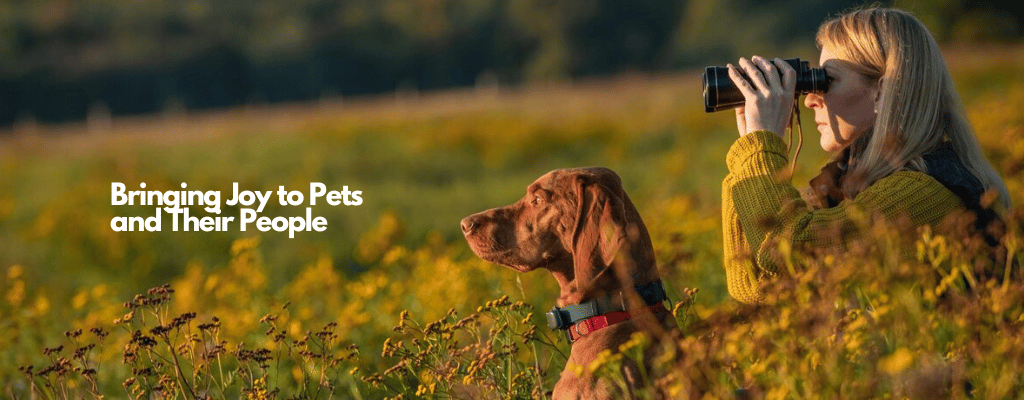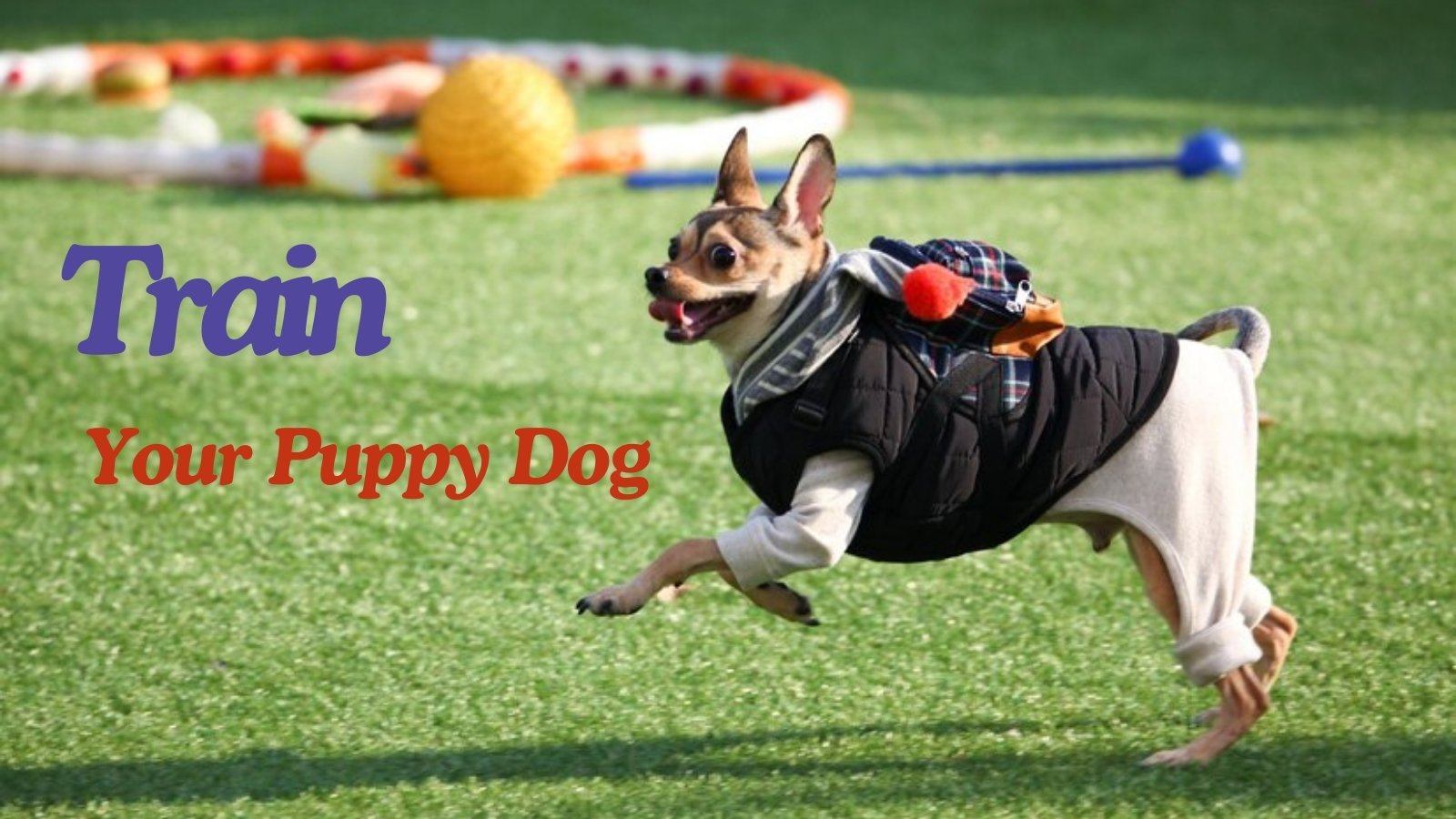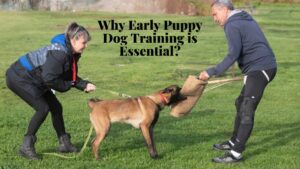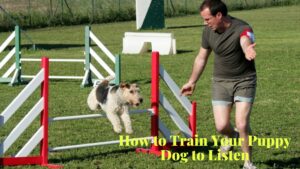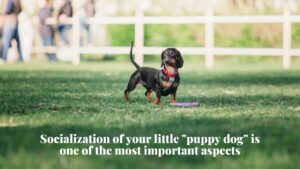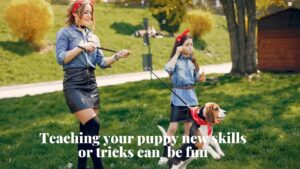Bringing an adorable “puppy dog” into your home is exciting and rewarding, but it has its challenges. The very first thing you want to do once you bring home your new furry friend is the well-known “puppy dog training” step, which is one of the many basic steps that will ensure they will be a well-behaved, lovely part of your life.
Whether you’re teaching your “puppy dog” essential commands or taking on more complex “puppy training techniques”, the experience of training your pup is vital to building a lasting bond for more behavioral issues in the future.
Read on for some expert tips (along with some tried and true methods) to help you through the early weeks of your “puppy dog” rearing. We will be covering everything from potty training to socialisation: we are going to take a look at how you can create a positive environment, build trust between you and your puppy and make sure your puppy’s childhood is on the best path possible! If done correctly, training can be an enjoyable experience for you and your “puppy dog”.
Why Early Puppy Dog Training is Essential for Success
When you adopt a “puppy dog,” the first few months you have them can be crucial in determining their behaviors and establishing a foundation for a well-trained adult dog.
When you think about early “puppy dog training”, you might consider teaching basic commands, such as “sit” and “stay”, to your new dog — but you should also focus on building a positive and structured environment, in which your puppy will feel safe and secure. The sooner you start training your “puppy dog,” the more successful in the long-term.
Because “puppy dog obedience training” starts at an early age, it encourages your puppy to adopt good habits that will last a lifetime. In these critical weeks, they are most open to learning new habits and getting along with people and other animals. Lack of early training can lead to habits that are much more difficult to break later down the line, such as chewing, jumping or barking.
Also, early training provides a clear expectation to your “puppy dog” on what the rules in the home may be. Introducing commands and reinforcing good behavior helps create security for your puppy as they learn how to interact in their environment.
Staying consistent in these early days is critical — “puppy dog housebreaking” and “puppy socialization” should begin as soon as you bring a matchbook home to avoid creating future frustrations down the line.
The advantages of early “puppy dog training” go far beyond obedience. If you put in the time and patience to train from the start, you will prepare both you and your pup for a long, happy, successful relationship.
The First Steps: Creating the Right Environment for Your Puppy Dog’s Training
Setting up the environment is just as important in “puppy dog training” as the training techniques themselves. Most importantly, ensure your puppy has a safe, quiet, and distraction-free environment in which to learn.
Properly shaping the environment prior to training sets the stage for successful training, and as a result, maximizing the potential for advancement in each training session for your “puppy dog”.
Selecting the Right Space For Training
Choosing an optimal environment starts with location. You should be in a calm and quiet place when beginning puppy dog obedience training. Puppies are curious by nature, and a loud, busy setting can easily overstimulated them.
Find a part of your home where it’s least likely you’ll be distracted — a mostly windowless room, or a corner away from the foot traffic. A quiet environment can help engage focus: The goal during training is to have your puppy’s undivided attention.
Comfort and Security for Your Puppy Dog
While you are working on your “puppy dog housebreaking” a comfy crate can be a great way to create a safe space for your puppy. The crate can prevent accidents and gives your puppy a spot to settle down when you’re not in a training session. It should have plenty of room and be comfortable, with a soft bed, and access to water, so your puppy will feel secure.
Along with the crate, you will need to gather the supplies for your training. For your “puppy dog” to work with you through your training, you will want to have a leash, treats, and toys.
Treats are one kind of “positive reinforcement” that works quite well—if you reward good behavior, your puppy is going to be more likely to do them again. Look for small, soft treats that your puppy can eat quickly and without distraction.
Routine and Consistency
Puppies love routine, and a set training schedule will allow your “puppy dog” to understand what’s being asked of them. Train every day at the same time, either morning or evening. Use the same commands, tone of voice, and hand signals, to prevent confusing your puppy.
For instance, if you are teaching your dog basic commands, like “sit” or “stay,” make sure to use the same word and the same gesture every time. This way, your puppy is more likely to understand what you want from him/her.
Eliminate Distractions
A “puppy dog” cannot focus if there are too many distractions. Make training sessions short but frequent — think 5 to 10 minutes at a time. If you are indoors, restrict access to windows, because activity outdoors can easily divert your puppy’s attention.
If you are training outdoors, select a quiet, familiar location where your puppy will not be distracted by pets or loud sounds.
Positive Reinforcement
Reward the right behaviors throughout training. When your “puppy dog” does what is asked, immediately reward them with praise or treat. Using positive reinforcement helps build trust between you and your puppy fostering the understanding that positive lemation can earn them good things giving your puppy extra motivation to do good.
With the right environment, you give the puppy dog in you the same structure and security needed to be successful. A space that is quiet and free of distractions, a consistent routine, and the proper tools will help to make success stories out of you and your puppy.
It makes the training process much easier and fun for both you, and your furbaby, resulting in a more perfectly adjusted pup, and an even stronger
How to Train Your Puppy Dog to Listen: Key Commands Every Puppy Needs to Learn
One of the goals of the puppy dog training is to get your puppy to listen to you. The earlier you start training your “puppy dog”, the more successful they’ll be at taking commands, not jumping up sparring, and behaving in public.
Essential commands such as “sit,” “stay,” “come” and “leave it” affect your puppy’s behavior when they are young but will pay off big time in the long run with a well-behaved dog.
Start with the basics. One of the most essential commands you will teach your ”pup dog” is the command “sit”. Start by simply holding a treat above their head and slowly bringing it back toward their tail. Your puppy will naturally sit to follow the treat.
As soon as their bottom makes contact with the ground, say “sit” and instantly treat them. The key here is consistency — you can repeat this process several times during short sessions.
Another early command to teach is “stay.” Start out with your puppy sitting and putting your hand up, like “stop.” Say “stay” in a calm, firm tone and step back. If your “puppy dog” stays, reward them with a treat and praise.
Increase the distance and duration slowly over time. You are so patient and use treats with your puppy as incentive to do the desired command.
“Come” is a basic command for safety. So, begin by calling your puppy dog’s name, then “come” in an upbeat, excited voice. When they come to you, praise and treat them.
Most importantly, please practice this command in a controlled, enclosed environment, prior to practicing in open areas. Reward the positive behavior consistently, and your puppy will respond reliably.
The “leave it” command is critical if you want to keep your puppy from picking up something they shouldn’t have. Have a treat in your hand and, as your puppy goes to grab it, firmly say “leave it.”
As soon as they stop attempting to grab the treat, praise them or give them another treat. This helps your “puppy dog” learn not to “do their business” and to pay attention to you.
So remain calm, and reinforce teach these fundamentals to your puppy dog. Training regularly, and providing praise and treats, will ensure your puppy learns quickly and develops a close relationship with you.
Potty Training Your Puppy Dog: Proven Methods That Work
It is also one of the first of the many “puppy dog training” steps, as well: Potty training, to establish good habits early. Consistency and patience is the vital ingredient to “housebreaking your puppy dog” successfully. Establishing a clear routine and rewarding positive behavior will ensure your puppy begins to learn where and when to relieve itself.
Creating a regular potty schedule is the first step in potty training your little “puppy dog”. Take your puppy out first thing in the morning, after meals, and before going to sleep.
Puppies have little tiny bladders, so they might need to head outdoors a lot. By keeping to a repeated schedule, you help your “puppy dog” understand when it’s a good time to go.
Use a designated potty ground when you take your puppy out. Redirect your puppy to the same area each time in order to create that association with going potty.
Praise or treat your puppy immediately after they go potty. Ensuring an abundance of positive reinforcement is the key to puppy dog housebreaking. The more your puppy connects going outside to rewards, the quicker they’ll catch on.
If your puppy has an accident indoors, do not punish them. All you need to do is clean it well with an enzyme cleaner to eliminate the smell so your puppy won’t return to the same spot. Punishing a dog can lead to confusion and fear, which is why focusing on the positive is necessary.
Crate training is another useful method. A crate is a safe, enclosed environment which your puppy is less likely to mess in. Since dogs naturally want to avoid soiling their sleeping space, the crate helps form a schedule in which your “puppy dog” learns to hold their bladder until you bring them outside. Puppies also have limited bladder control, so take care not to leave your puppy in the crate for too long.
Potty training your new “puppy dog” takes consistency and patience. During the day, supervise your puppy closely so you can see the signs they must go out, such as sniffing or circling. The sooner you are reliable in taking your puppy outside and rewarding them for being good the quicker they will make the connection.
You’ll be sure to successfully “housebreak your puppy dog”, and have a clean and well-behaved pup in no time, as long as you stick to a routine, reward him when he does the right thing, and don’t get frustrated.
Socializing Your Puppy Dog: How to Create a Confident and Friendly Pup
Socialization of your little “puppy dog” is one of the most important aspects in “puppy dog training”. Proper socialization will make sure that your puppy becomes a confident, friendly, and well-adjusted adult. You are going to do this in a safe and controlled way so that your “puppy dog” can learn how to interact with people, the environment and each other.
Socialize from a young age—ideally, between 3 and 14 weeks old. Your “puppy dog” is most willing to accept new experiences during this vital period. Expose your puppy to different sounds, sights and smells: car rides, household sounds, different types of terrain (grass, gravel). This early socialization will build your puppy’s confidence and prevent fear-based responses in the future.
As your pup interact with folks, make sure your new “puppy dog” meets many lots of people, young children, adults, and strangers. This will also help them get used to people of all ages and looks.
Always supervise these interactions, and make sure the experiences stay positive. Let your puppy come up to you on their own time and reward them for being calm.
Equally important for social development is meeting other dogs! Begin with well-mannered, vaccinated dogs in a controlled setting, such as a puppy class or playdate with a friend’s dog.
Limit the length of initial interactions, and always pay attention to your puppy’s body language. The duration of socializing increases with the comfort level of your “puppy dog”.
Socialization is not limited to meeting other dogs and people; being around different environments is a big part of it as well. Walk your puppy, go to dog-friendly stores, or enroll in puppy classes. Allowing your “puppy dog” to be exposed to new environments, sounds and distractions will help her/him stay calm and confident when it matters.
Socializing your little puppy dog requires positive reinforcement. Whenever your puppy approaches a new situation or person without reacting, be sure to reward them with treats and praise. This associations new experiences with pleasure, prodding your puppy to participate with confidence.
Early and consistent socialization of your “puppy dog” will grow them into a friendly, well-adjusted companion. A well-socialized puppy is much more likely to enjoy meeting new people, having new experiences and deal with new situations with confidence.
Common Mistakes to Avoid When Training Your Puppy Dog
Owning a “puppy dog” is an exciting experience, however it can also be difficult at times. There are lots of common pitfalls that new pet owners make which can slow down the training journey or make your puppy confused. Awareness of and avoiding these common mistakes will make your “puppy dog training” journey smoother and more productive.
One of the biggest mistakes is also being inconsistent. If you’re inconsistent in rewarding, issuing commands, or keeping to your dog’s routine, your “puppy dog” won’t be able to know what’s required.
Use the same words every time for commands (such as “sit,” not “sit down”) and be consistent in your tone and hand gestures. It will help you and your puppy quickly understand what the commands are, and what specific behavior they are for.
You punish your puppy for errors. While dogs are still puppies, they are in the process of learning and may have accidents or make mistakes during training. Punishment, especially harsh punishment, breeds fear and confusion, which serves to erode the bond you have with your puppy. Instead, think about “positive reinforcement”. Your puppy will learn that good behaviour earns him a reward, thanks to positive reinforcement.
Owners also often do the opposite where they are training for too long in one session. Because puppies have short attention spans, it is critical to keep training sessions short and focused. Think in terms of multiple short hits over the end of the day, not one long hit. This will keep your puppy engaged without becoming frustrated or overwhelmed.
One mistake often made with “puppy dog housebreaking” is failing to set up a consistent potty routine. Puppies need to go to the bathroom often, particularly when they’re younger.
Be sure to take your puppy outside at regular intervals, after eating, napping and playing. Use positive reinforcement on your puppy by giving them a treat each time they use the potty outside.
Finally, if you don’t take the time to make time for “puppy socialization,” it can start behavioral problems down the line. Socialization is a vital aspect of “puppy dog training” that prepares your puppy to feel comfortable being around other dogs, people, and different environments. A lack of this step can lead to fear, anxiety and aggression in your puppy’s future.
If you can avoid these common mistakes—lack of consistency, punishment, over-training, neglecting potty training, and socialization—your puppy dog’s will be positive, effective, and make the whole process enjoyable for the both of you. Raising a well behaved and confident puppy is all about consistency, patience and positive reinforcement!
Building a Strong Bond with Your Puppy Dog: The Key to Effective Training
Perhaps the most crucial element of puppy dog training is creating a solid, trusting relationship with your puppy. And training becomes more effective in a wholesome relationship and the association is long-lasting. Building a breeding foundation with your puppy on trust, communication, and mutual respect will keep the growth happening in all the expanding areas of your puppy’s life.
The important measure of building a strong bond with your puppy is by spending quality time with your puppy. And that doesn’t necessarily mean training time, but also playtime and downtime.
So activities your puppy likes, like fetch, play or just snuggles. This will allow your puppy to view you as their source of safety and happiness and will make them more willing to listen to you in training.
The other very important element of bonding is positive reinforcement. The big secret to being a successful “puppy dog” is to reward your 4-legged friend immediately when they listen to a command or are behaving well, by giving them treats, positive praise or with a toy.
This helps your puppy build a positive association with you. With time, your puppy will learn to trust you in a leadership role and feel more confident in your presence.
Furthermore, always display patience and understanding. Puppies are still getting used to the world around them and might make some mistakes along the way.
If they do, rather than becoming frustrated, quietly guide them back to the appropriate behavior. This patience creates trust and teaches your “puppy dog” to turn to you for direction.
Advanced Puppy Dog Training: Teaching Your Pup to Master New Skills
Once your “puppy dog” has mastered the basics of training, you need to challenge them with more advanced skills. Teaching your puppy new skills or tricks can be fun as well as mentally stimulating and beneficial to your puppy’s growth.
Focus on easy-for-you tricks but tricks that require your attention. Commands such as “shake hands,” “roll over” or “play dead” are amusing and fairly easy to teach. The key to teaching a new trick is to break it down into baby steps.
So, for instance, if you were attempting to teach your “puppy dog” to roll, you would start in the “down” position, and then gently move their body in the position of rolling over whilst describing to them visually the command “ROLL” When they successfully perform the trick, reward them immediately.
Once your “puppy dog” masters the fundamentals, you can begin working on more advanced skills. This could include agility training, teaching your puppy to retrieve certain figurative items or even more advanced commands, like “wait” or “leave it” in more complicated situations.
For instance, you may construct a mini agility path in your garden with tunnels, ramps or hurdles to see how well your puppy follows commands while exercising.
Puppies need as much mental stimulation as they do physical exercise. Such training (in which your “puppy dog” is tasked with finding hidden morsels or learning interactive puzzle-box toys) keeps their brain busy. Staying mentally stimulated helps curtail boredom and unwanted behaviors like chewing or barking excessively.
Remember to only work on advanced skills in short and fun bursts. Keep it light in the atmosphere, and whatever you do, be patient. Remember that puppies are still learning advanced commands, so it can take some extra time for them to fully comprehend, that is why consistency is important.
You build the confidence of your “puppy dog,” stave off boredom, and strengthen your bond together by introducing new challenges and rewards through advanced training techniques.
Whatever you’re doing, from teaching a new trick to agility training or engaging them in puzzle toys, the activities will turn your puppy into a happy well-rounded dog that can’t wait to learn new tricks.
Conclusion:
So, due to the fact it is essential to teach your reliable “puppy dog”. It’s also a fulfilling journey that demands determination and strength. By introducing them to basic foundation work that builds trust and working up to advanced skills, you will ensure a lifetime bond with your puppy.
The keys to developing a well-mannered pup are early socialization, a positive and consistent environment to learn in, and using “positive reinforcement.”
Just keep in mind that every puppy is different, and the amount of time it takes for these cues to “stick” will vary. Rejoice in each small victory, give grace during setbacks, and always emphasize positive reinforcement.
Whether teaching your “puppy dog” basic commands, house training, or more advanced skills, the time you invest in training will result in a well-behaved, happy and confident dog.
When used appropriately, you will be successful in developing a well-behaved puppy that is pleasant to be around, loyal and cheerful in any environment or situation. Train in a way that is fun, rewarding and engaging, and you will have a puppy dog who grows into the most cherished version of themselves.
Investing in your puppy dog’s training now lays the groundwork for a lifetime of great behavior, rich companionship, and fun adventures. So, get your treats, leash, and plenty of patience — your puppy’s road to becoming a well-trained and well-mannered dog starts today!
source link
American Kennel Club (AKC) – Comprehensive training resources for puppies, including tips on basic commands, socialization, and problem-solving.
PetMD – Provides expert advice on puppy care, including housebreaking, training, and behavior management.
RSPCA – The Royal Society for the Prevention of Cruelty to Animals provides expert tips for training puppies, including housetraining and obedience training.
